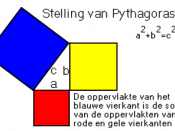Pythagoras
Pythagoras' Theorem is a2 + b2 = c2. 'a' being the shortest side usually the adjacent 'b' being the middle length side usually the opposite and 'c' being the longest side always the hypotenuse. This theorem only works in 'Right angled triangles'.
The numbers 3, 4 and 5 satisfy the condition.
32 + 42 = 52
This is because 32 = 9 and 42 = 16, 9 + 16 = 25, and 52 = 25, therefore 32 + 42 = 52.
The numbers 5, 12 and 13 and 7, 24 and 25 also satisfy the condition.
52 + 122 = 132
52 = 25
122 = 144
132 = 169
25 (52) + 144 (122 ) = 169 (132 )
72 + 242 = 252
72 = 49
242 = 576
252 = 625
49 (72) + 576 (242) = 625 (252)
Perimeter (3, 4 and 5)
3 + 4 + 5 = 12
Area (3, 4, and 5)
ý x 3 x 4 = 6
Perimeter (5, 12 and 13)
5 + 12 + 13 = 30
Area (5, 12 and 13)
ý x 5 x 12 = 30
Perimeter (7, 24 and 25)
7 + 24 + 25 = 56
Area (7, 24 and 25)
ý X 7 X 24 = 84
From the first 3 terms I have noticed the following:
ÃÂ'a' increases by 2 in each term
ÃÂ'a' is equal to the term number multiplied by 2 then add 1
ÃÂthe last digit of 'b' is in a pattern 4, 2, 4
ÃÂthe last digit of 'c' is in a pattern 5, 3, 5
ÃÂthe square root of ('b' + 'c') = 'a'
ÃÂ'c' is always +1 to 'b'
ÃÂ'b' increases by 4 each term
ÃÂ('a' x 'n') + n = 'b'
From the...


